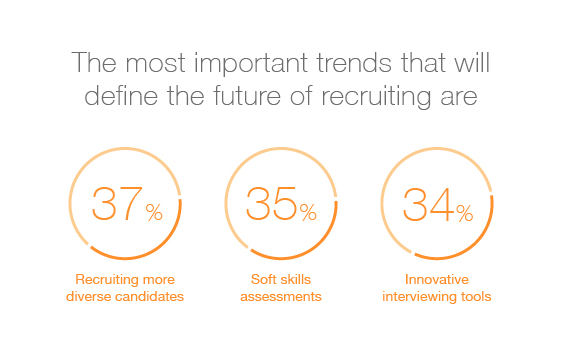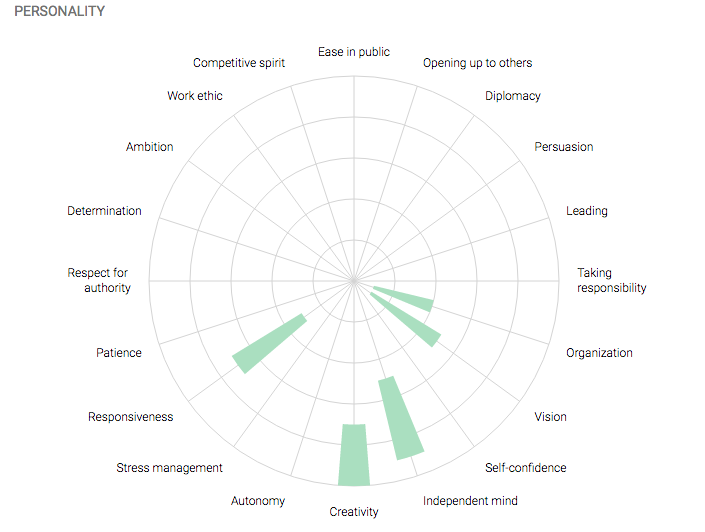Top 3 worldwide recruiting trends in 2017

We recently hosted Silicon Valley Recruiters Association (SVRA) at our San Francisco office. The highlight was the panel of 6 experts who spoke about the top problems recruiters face, the importance of data driven soft skills analysis, and the overall trends they foresee for recruiting in 2017 and beyond. Watch the full replay here.
Today we will be featuring the insights of panelist Sankar Venkatraman who has been the Group Product Marketing Manager at LinkedIn for the last five years.
Venkatraman presented data from LinkedIn’s 2017 Annual Global Recruiting Trends Report in which over 4,000 recruiters spanning 35 countries were interviewed about challenges they face, the trends that will define the future of recruiting, how they spend their budgets and where they would like to invest in the future.
Biggest Challenge Recruiters Face: Competition for Talent
According to LinkedIn, by far the greatest challenge recruiters face is competition for talent. Venkatraman simply described this as “how do I stand out in the workplace?” He talked about how he believes LinkedIn initially created this problem because it made it very easy for people to source and find people. The problem is no longer “how do I find a java engineer” but “how do I make it clear that my company is the best place for this java engineer?” He made an interesting connection between this problem and a future trend of recruiting, soft skills, connecting the dots of problem and potential solution, stating that “Talentoday is in the right space for the upcoming 5 years”. Understanding and valuing a candidate’s soft skills and professional motivators will be more important than ever when placing people in the right jobs.
Top Trends that Define the Future of Recruiting
In addition to the biggest challenges recruiters will face, Venkatraman walked us through the top trends projected by LinkedIn. He focused much of his attention on automation. The data shows that recruiters report limited headcount and budget yet hiring demands are growing. Let’s take a closer look at the top three trends you can expect to see in the next 5 years of recruiting.

1. Diversity of Candidates
Not only does hiring diverse candidates boost innovation and creativity in the workplace, but by focusing on diversity over time, recruiting success is increased. As we mentioned earlier, competition is the greatest challenge we face as recruiters, and research indicates that diversity attracts talent. According to a Glassdoor survey, two-thirds of people value diversity as important when deciding where to work, the numbers increasing up to 89% of minority job seekers.
It is important to implement this now as it takes time to build a diverse workforce; culture doesn’t pop up overnight. Having a diverse set of employees can also help decrease turnover rates. The same Glassdoor survey said the majority of people wish their employers were doing more to foster diversity — don’t let lack of diversity be the reason your talent is walking out the door early.
*We will be doing a follow up blog with more tips and tricks on how to recruit a diverse population as other panelists went into this in detail, stay tuned!
2. Soft Skills Assessment
When talking trends, soft skills assessment paired with automation were the meat and potatoes of Venkatraman’s presentation. He started by stating the obvious — recruiters are busy. Their teams typically aren’t growing while other teams at their companies’ are. What does this mean for recruiting trends? In this conversation, it boiled down to the screening process. Recruiters need less “noise”. According to Venkatraman, it’s not about how many applicants you have but how many quality applicants you have. Data can help reduce the workload of recruiters and narrow down the quantity of resumes to fewer quality candidates.
There are two main ways that data can help with screening. The more obvious being automated screening which we will get to next in our third vtrend, innovative interviewing tools. The second is that automation can offer a more precise soft skills assessment.
Understanding the hard skills of an individual is pretty straight forward. They have the skill, or they do not. But what is more important these days is an individual’s ability to learn. You can teach someone to code in Javascript but you cannot teach them to have a strong work ethic, how to lead or how to be creative. These are innate traits that are formed over the course of a lifetime, traits that would be nice to know about when hiring for your company. The future, as Venkatraman mentioned will rest on assessments that allow you to measure these traits quickly yet thoroughly.
3. Innovative Interviewing Tools
The other piece to the automation process is innovative interviewing tools. As we mentioned, automation is key. Venkatraman stated how it is imperative for efficiency that recruiters are not screening through millions of candidates for a single job. Automation brings speed and also minimizes human bias which may increase diversity (see how these are all related). Utilizing platforms like HireRight to automate background checks or Hireart to preform video screening of candidates are just a few examples of the tools out there to help simplify interview success.
To summarize, large companies will be focusing on big data to help them attract the most diverse and best talent in the future of recruiting. If you would like to watch the interview with Sankar Venkatraman or the full panel of talent speakers, you can watch here. Stay tuned for more blogs on the other panelists.
— Talentoday
Want valuable insights on your top recruits ? Start your free trial today and use predictive analytics and psychology to make smart hiring decisions. And if you like this post, please hit the ❤️ button below or give me a shout on Twitter.
How to hire a super star sales professional.
3 unique traits in those who close deals
A great product or service can easily go unnoticed if it does not have the right people to sell it. As a hiring manager, how can you find sales stars that shine? With thousands of sales professionals in our data base, we have created a profile on what makes an individual a great deal closer — & it is not what you may think. According to our data, top sales performers display the following traits:

#1 Creative: Lives (and thinks) outside the box
There are many ways to sell a product or service, and the same approach is not right for everyone. Creativity is often required to take a customer from “maybe” to “yes” and close a deal.
A successful salesperson thrives in an environment where they need to constantly adapt to changing goals and creatively solve problems on a daily basis. You don’t want someone who sometimes thinks outside the box, you want someone who doesn’t know that the box even exists.
#2 Responsive: Intuition based decision making
Have you ever felt like the car salesman down the street read your mind? Well, they did. Salesmen/women rely so heavily on their intuition that they can easily get in their customers head and are usually two steps ahead. Genuine sales professionals are quick on their feet, and favor spontaneous action over reflection.
But while they are quick they are also swift and can adapt to a new situation at the drop of a hat. Their chameleon like nature allows them to respond to the personalities of a rainbow of potential customers.
Team members who have mastered the art of clear and consistent communication with their clients will lead your company to higher customer satisfaction, and a better bottom line as a result.
#3 Independent mind: Supervision not required
A rockstar salesperson should be able to take a goal and run with it. That means setting their own schedule and ensuring that all relevant goals are met on time.
Self motivation is crucial, especially in environments where sales reps work remotely or travel frequently. Managers should be able to support their teams without getting in the weeds on day-to-day details.
The total superstar sales package
The key to making a sale is understanding customers’ needs and figuring out how your product or service can meet them — the intersection of creativity, responsiveness, and independence. Find someone who has all three and you are well on your way to success.
While every employee is unique, these insights may help you determine which applications rise to the top of the pile. For help hiring your next sales professional use this job matching system to see how your candidates stack up against your current sales team. Stop relying on your gut instinct for hiring (leave that to sales) and start making data-driven decisions.
Want to read more recruiting tips and tricks? Check out my blog page.


